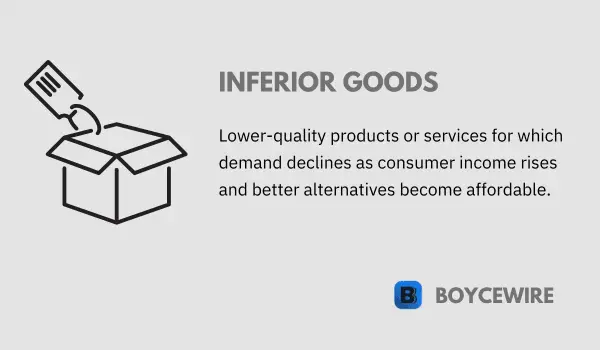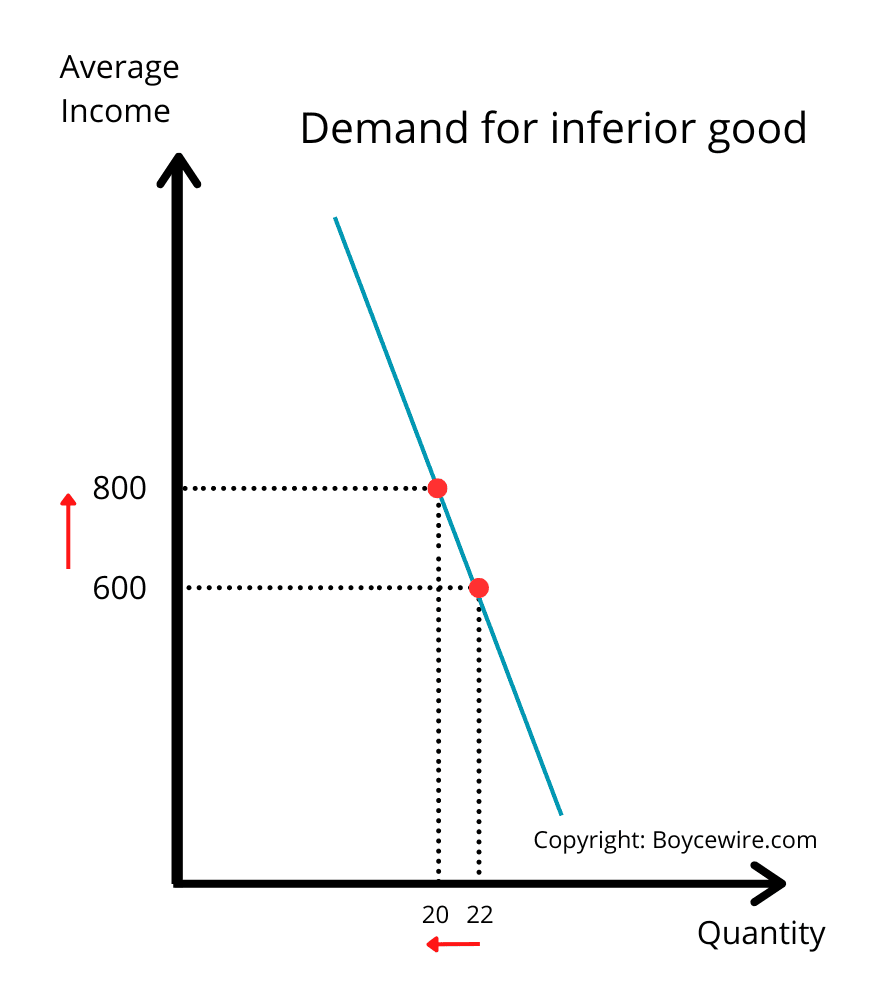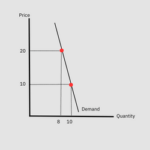Inferior Goods: Definition, Characteristics & Examples

What are Inferior Goods?
Inferior goods are products or services that see a decrease in demand as consumer income increases. In other words, when people have more money to spend, they typically opt for higher-quality or more expensive alternatives.
Despite their negative connotation, inferior goods play a crucial role in the market, and understanding their dynamics can help businesses and policymakers make informed decisions.
Key Points
- Inferior goods are products or services for which demand decreases as consumer income increases.
- Inferior goods have a negative income elasticity of demand, meaning that as income rises, the demand for these goods decreases.
- They typically of lower quality compared to higher-priced alternatives. As consumers’ incomes increase, they tend to switch to higher-quality substitutes.
Characteristics of Inferior Goods
Inferior goods possess specific attributes that distinguish them from other types of goods in the market. These characteristics not only help to define them but also provide insights into the consumer behaviors associated with them. Here are some key characteristics:
- Negative Income Elasticity of Demand: they exhibit a negative income elasticity of demand, meaning that as consumers’ income rises, the demand for these goods decreases. This contrasts with normal goods, where demand increases with higher income levels.
- Substitutes: they often have substitutes in the form of higher-quality or more expensive products. When consumers experience an increase in their income, they tend to switch to these alternatives, leading to a decrease in demand for inferior goods.
- Affordability: they are typically more affordable than their substitutes, making them attractive to consumers with lower incomes or during economic downturns. This affordability is one of the reasons why inferior goods remain relevant in the market.
- Quality and Perception: they are often perceived as being of lower quality compared to their more expensive counterparts. However, it is essential to note that the term “inferior” does not necessarily imply that these goods are of poor quality, but rather that they are less preferred by consumers when income levels rise.
- Price Sensitivity: Consumers of inferior goods are usually more price-sensitive, as they tend to have lower incomes or are more frugal with their spending. As a result, small changes in price can significantly impact the demand for such goods.
Understanding these characteristics can help businesses and economists gain insight into consumer behavior and preferences, allowing them to make informed decisions about product development, pricing strategies, and market segmentation.
Factors Affecting Demand for Inferior Goods
Various factors can influence the demand for inferior goods in the market. A clear understanding of these factors can help businesses, economists, and policymakers better predict consumer behavior and develop appropriate strategies. Some of the significant factors affecting the demand for inferior goods include:
- Income Level: The most critical factor affecting the demand for inferior goods is the income level of consumers. As consumer income increases, the demand for inferior goods tends to decrease, as people opt for higher-quality or more expensive substitutes.
- Economic Conditions: The overall state of the economy can also impact the demand for inferior goods. During periods of economic growth, when income levels rise, the demand for inferior goods is likely to decline. Conversely, during economic downturns or recessions, when incomes fall or unemployment rises, consumers may prioritize affordability, leading to increased demand for inferior goods.
- Price Changes: Changes in the prices of inferior goods or their substitutes can significantly affect their demand. For example, if the price of an inferior good decreases, its demand may increase as it becomes even more affordable. On the other hand, if the price of a substitute good decreases, consumers may switch to the substitute, reducing the demand for the inferior good.
- Consumer Preferences and Tastes: Consumer preferences and tastes can also influence the demand for inferior goods. Cultural, social, or personal factors might lead some individuals to prefer inferior goods despite having higher incomes, while others may avoid them even during economic downturns.
- Market Trends and Fashions: Trends and fashions can play a role in shaping the demand for inferior goods. For example, a sudden surge in popularity for a specific inferior good due to a marketing campaign or social media influencer endorsement could temporarily increase its demand, even among higher-income consumers.
By understanding the factors that affect the demand for such goods, businesses and policymakers can make more informed decisions about product development, marketing, and economic policy to cater to the changing preferences and needs of consumers.
Examples of Inferior Goods
Inferior goods are those that see a decrease in demand as consumers’ income levels rise. While they may serve a necessary purpose during times of economic difficulty, consumers often prefer to upgrade to better-quality alternatives when they can afford to do so. Some common examples include:
1. Generic or Store-brand Products
Generic or store-brand products are often considered inferior goods because they typically offer lower prices and quality compared to their branded counterparts. As consumers’ income levels rise, they may choose to purchase the more expensive, higher-quality branded products instead.
2. Fast Food
Fast food is another example. While it provides a convenient and affordable option for dining, people with higher incomes may choose to eat at more upscale restaurants or cook healthier meals at home as their disposable income increases.
3. Used Cars
Used cars are often considered inferior to new cars because they tend to be older, have more mileage, and offer fewer features. As consumers’ incomes rise, they may opt for a new car with better performance, safety features, and the latest technology.
4. Public Transportation
Public transportation can be considered an inferior good as well, as people with higher incomes may choose to purchase their own vehicles or use ride-sharing services for increased comfort and convenience.
5. Discount Clothing
Budget clothing retailers that offer lower-quality garments at affordable prices are another example. When consumers have higher incomes, they may choose to shop at higher-end retailers for more durable and fashionable clothing options.
Normal Goods vs. Inferior Goods
In the realm of economics, goods are generally classified into two categories based on how consumer demand for them changes with income levels: normal goods and inferior goods. Understanding the differences between these two types of goods is crucial for businesses and policymakers to predict changes in demand as economic conditions evolve.
Normal Goods:
- Definition: Normal goods are those for which demand increases as consumers’ income levels rise. As people have more disposable income, they tend to buy more of these goods or services.
- Examples: Normal goods can include high-quality clothing, organic food, luxury cars, electronics, and dining at upscale restaurants. These goods are generally perceived as higher quality or offering additional features and benefits compared to their lower-priced alternatives.
- Income Elasticity: The income elasticity of demand for normal goods is positive, meaning that as income increases, the quantity demanded for these goods also increases. The degree of responsiveness, however, may vary depending on the specific good.
Inferior Goods:
- Definition: Inferior goods, on the other hand, are those for which demand decreases as consumers’ income levels rise. As people have more disposable income, they tend to buy less of these goods, often opting for higher-quality alternatives.
- Examples: can include generic or store-brand products, fast food, used cars, public transportation, and discount clothing. While these goods may serve a necessary purpose during times of economic difficulty, consumers often prefer to upgrade to better-quality alternatives when they can afford to do so.
- Income Elasticity: The income elasticity of demand is negative, meaning that as income increases, the quantity demanded for these goods decreases. Similar to normal goods, the degree of responsiveness can vary depending on the specific good.
In summary, the key difference between normal goods and inferior goods lies in how consumer demand for them changes with income levels. For normal goods, demand increases as income rises, while for inferior goods, demand decreases as income rises. Both types of goods play important roles in the economy, and understanding these differences can help businesses and policymakers make informed decisions about production, pricing, and policy.
Inferior Goods Graph
In economics, graphical representations help visualize the relationship between variables and simplify complex concepts. In the case of inferior goods, a graph can help illustrate how the quantity demanded changes in response to changes in consumers’ income levels.
To create a graph illustrating the relationship between income and the quantity demanded for inferior goods, we use the following axes:
- Horizontal axis (X-axis): This represents the quantity demanded.
- Vertical axis (Y-axis): This represents consumers’ income levels.
In the graph, we plot a downward-sloping curve known as the ‘inferior goods demand curve.’ The curve’s negative slope indicates that as consumers’ income levels increase (moving up along the Y-axis), the quantity demanded decreases (moving left along the X-axis). Conversely, as income levels decrease (moving down along the Y-axis), the quantity demanded increases (moving right along the X-axis).

The inferior goods demand curve’s slope may vary depending on the specific good, reflecting the degree to which consumers are willing to substitute such goods for higher-quality alternatives as their income levels change.
In summary, the graph illustrates the negative relationship between consumers’ income levels and the quantity demanded. As income levels increase, consumers tend to buy less, opting for higher-quality alternatives instead. This relationship is represented by a downward-sloping demand curve on the graph.
FAQs
Inferior goods are products or services for which demand decreases as consumer income rises.
Unlike normal goods, the demand for inferior goods decreases as income increases, whereas normal goods experience an increase in demand with rising income.
The decrease in demand for inferior goods with higher income is primarily due to consumers’ ability to afford and choose higher-quality substitutes.
Common examples of inferior goods include generic or lower-quality food items, used or outdated electronics, public transportation, and certain fast-food chains.
About Paul
Paul Boyce is an economics editor with over 10 years experience in the industry. Currently working as a consultant within the financial services sector, Paul is the CEO and chief editor of BoyceWire. He has written publications for FEE, the Mises Institute, and many others.

Further Reading
 Inelastic Demand: Definition & Examples - Inelastic demand is where the demand for a good does not significantly respond to changes in price.
Inelastic Demand: Definition & Examples - Inelastic demand is where the demand for a good does not significantly respond to changes in price.  Laissez-faire Economics: What it is & Example - Laissez faire economics is characterised by the absence of government involvement in the economic interactions between parties.
Laissez-faire Economics: What it is & Example - Laissez faire economics is characterised by the absence of government involvement in the economic interactions between parties.  Hindsight Bias: Definition & Examples - Hindsight bias is where an individual claims to have been able to predict an event after it has happened.
Hindsight Bias: Definition & Examples - Hindsight bias is where an individual claims to have been able to predict an event after it has happened. 